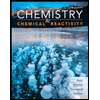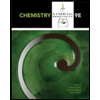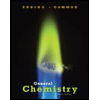
CHEMISTRY:MOLECULAR...-CONNECT ACCESS
9th Edition
ISBN: 9781260477368
Author: SILBERBERG
Publisher: INTER MCG
expand_more
expand_more
format_list_bulleted
Question
Chapter 18.5, Problem 18.9AFP
Interpretation Introduction
Interpretation: Given the concentration of the solution, the equilibrium values of
Concept Introduction: The pH scale will range from 1-14. pH is the negative logarithm of hydrogen ion concentration. If pH is greater than 7 then the solution is basic, less than 7 then the solution is acidic and if it is equal to 7 the solution will be neutral. pH and pOH are related by the equation:
pH + pOH =14
Oxalic acid is a weak acid, so it will not dissociate completely and since it is polyprotic in nature dissociation will take place in two steps. Therefore, oxalic acid has two
Expert Solution & Answer
Want to see the full answer?
Check out a sample textbook solution
Students have asked these similar questions
draw the major product formed with the listed reagents
Propose Williamson ether syntheses for the following compounds
Identify all functional groups
Chapter 18 Solutions
CHEMISTRY:MOLECULAR...-CONNECT ACCESS
Ch. 18.2 - Prob. 18.1AFPCh. 18.2 - Prob. 18.1BFPCh. 18.2 - Prob. 18.2AFPCh. 18.2 - Prob. 18.2BFPCh. 18.2 - Prob. 18.3AFPCh. 18.2 - Prob. 18.3BFPCh. 18.3 - Prob. 18.4AFPCh. 18.3 - Prob. 18.4BFPCh. 18.4 - Prob. 18.5AFPCh. 18.4 - Prob. 18.5BFP
Ch. 18.5 - Prob. 18.6AFPCh. 18.5 - Prob. 18.6BFPCh. 18.5 - Prob. 18.7AFPCh. 18.5 - Prob. 18.7BFPCh. 18.5 - Prob. 18.8AFPCh. 18.5 - Prob. 18.8BFPCh. 18.5 - Prob. 18.9AFPCh. 18.5 - Prob. 18.9BFPCh. 18.7 - Prob. 18.10AFPCh. 18.7 - Prob. 18.10BFPCh. 18.7 - Prob. 18.11AFPCh. 18.7 - Prob. 18.11BFPCh. 18.8 - Prob. 18.12AFPCh. 18.8 - Prob. 18.12BFPCh. 18.8 - Prob. 18.13AFPCh. 18.8 - Prob. 18.13BFPCh. 18.10 - Prob. 18.14AFPCh. 18.10 - Prob. 18.14BFPCh. 18 - Prob. 18.1PCh. 18 - Prob. 18.2PCh. 18 - Prob. 18.3PCh. 18 - Prob. 18.4PCh. 18 - Prob. 18.5PCh. 18 - Prob. 18.6PCh. 18 - Which of the following are Arrhenius...Ch. 18 - Prob. 18.8PCh. 18 - Prob. 18.9PCh. 18 - A Brønstcd-Lowry acid-base reaction proceeds in...Ch. 18 - Prob. 18.11PCh. 18 - Give the formula of the conjugate...Ch. 18 - Give the formula of the conjugate base:
Ch. 18 - Give the formula of the conjugate...Ch. 18 - Prob. 18.15PCh. 18 - Prob. 18.16PCh. 18 - In each equation, label the acids, bases, and...Ch. 18 - Prob. 18.18PCh. 18 - Prob. 18.19PCh. 18 - Prob. 18.20PCh. 18 - Prob. 18.21PCh. 18 - Prob. 18.22PCh. 18 - The following aqueous species constitute two...Ch. 18 - Prob. 18.24PCh. 18 - Use Figure 18.8 to determine whether Kc > 1...Ch. 18 - Prob. 18.26PCh. 18 - Prob. 18.27PCh. 18 - Prob. 18.28PCh. 18 - Prob. 18.29PCh. 18 - Prob. 18.30PCh. 18 - Which solution has the higher pH? Explain.
A 0.1 M...Ch. 18 - Prob. 18.32PCh. 18 - Prob. 18.33PCh. 18 - Prob. 18.34PCh. 18 - Prob. 18.35PCh. 18 - Prob. 18.36PCh. 18 - Prob. 18.37PCh. 18 - Prob. 18.38PCh. 18 - Prob. 18.39PCh. 18 - The two molecular scenes shown depict the relative...Ch. 18 - Prob. 18.41PCh. 18 - Prob. 18.42PCh. 18 - Prob. 18.43PCh. 18 - Prob. 18.44PCh. 18 - Prob. 18.45PCh. 18 - (a) What is the pH of 0.0111 M NaOH? Is the...Ch. 18 - (a) What is the pH of 0.0333 M HNO3? Is the...Ch. 18 - Prob. 18.48PCh. 18 - (a) What is the pH of 7.52×10−4 M CsOH? Is the...Ch. 18 - Prob. 18.50PCh. 18 - Prob. 18.51PCh. 18 - Prob. 18.52PCh. 18 - Prob. 18.53PCh. 18 - Prob. 18.54PCh. 18 - Prob. 18.55PCh. 18 - Prob. 18.56PCh. 18 - Prob. 18.57PCh. 18 - Prob. 18.58PCh. 18 - Prob. 18.59PCh. 18 - Prob. 18.60PCh. 18 - Prob. 18.61PCh. 18 - Prob. 18.62PCh. 18 - Prob. 18.63PCh. 18 - Prob. 18.64PCh. 18 - Prob. 18.65PCh. 18 - Prob. 18.66PCh. 18 - Prob. 18.67PCh. 18 - Hypochlorous acid, HClO, has a pKa of 7.54. What...Ch. 18 - Prob. 18.69PCh. 18 - Prob. 18.70PCh. 18 - Prob. 18.71PCh. 18 - Prob. 18.72PCh. 18 - Prob. 18.73PCh. 18 - Prob. 18.74PCh. 18 - Prob. 18.75PCh. 18 - Prob. 18.76PCh. 18 - Prob. 18.77PCh. 18 - Prob. 18.78PCh. 18 - Prob. 18.79PCh. 18 - Prob. 18.80PCh. 18 - Prob. 18.81PCh. 18 - Formic acid, HCOOH, the simplest carboxylic acid,...Ch. 18 - Across a period, how does the electronegativity of...Ch. 18 - How does the atomic size of a nonmetal affect the...Ch. 18 - Prob. 18.85PCh. 18 - Prob. 18.86PCh. 18 - Prob. 18.87PCh. 18 - Prob. 18.88PCh. 18 - Choose the stronger acid in each of the following...Ch. 18 - Prob. 18.90PCh. 18 - Prob. 18.91PCh. 18 - Prob. 18.92PCh. 18 - Use Appendix C to choose the solution with the...Ch. 18 - Prob. 18.94PCh. 18 - Prob. 18.95PCh. 18 - Prob. 18.96PCh. 18 - Prob. 18.97PCh. 18 - Prob. 18.98PCh. 18 - Prob. 18.99PCh. 18 - Prob. 18.100PCh. 18 - Prob. 18.101PCh. 18 - Prob. 18.102PCh. 18 - Prob. 18.103PCh. 18 - Prob. 18.104PCh. 18 - Prob. 18.105PCh. 18 - Prob. 18.106PCh. 18 - Prob. 18.107PCh. 18 - What is the pKb of ?
What is the pKa of the...Ch. 18 - Prob. 18.109PCh. 18 - Prob. 18.110PCh. 18 - Prob. 18.111PCh. 18 - Prob. 18.112PCh. 18 - Prob. 18.113PCh. 18 - Prob. 18.114PCh. 18 - Prob. 18.115PCh. 18 - Prob. 18.116PCh. 18 - Prob. 18.117PCh. 18 - Prob. 18.118PCh. 18 - Prob. 18.119PCh. 18 - Prob. 18.120PCh. 18 - Prob. 18.121PCh. 18 - Prob. 18.122PCh. 18 - Prob. 18.123PCh. 18 - Explain with equations and calculations, when...Ch. 18 - Prob. 18.125PCh. 18 - Prob. 18.126PCh. 18 - Rank the following salts in order of increasing pH...Ch. 18 - Rank the following salts in order of decreasing pH...Ch. 18 - Prob. 18.129PCh. 18 - Prob. 18.130PCh. 18 - Prob. 18.131PCh. 18 - Prob. 18.132PCh. 18 - Prob. 18.133PCh. 18 - Prob. 18.134PCh. 18 - Prob. 18.135PCh. 18 - Prob. 18.136PCh. 18 - Prob. 18.137PCh. 18 - Prob. 18.138PCh. 18 - Which are Lewis acids and which are Lewis...Ch. 18 - Prob. 18.140PCh. 18 - Prob. 18.141PCh. 18 - Prob. 18.142PCh. 18 - Prob. 18.143PCh. 18 - Classify the following as Arrhenius,...Ch. 18 - Chloral (Cl3C—CH=O) forms a monohydrate, chloral...Ch. 18 - Prob. 18.146PCh. 18 - Prob. 18.147PCh. 18 - Prob. 18.148PCh. 18 - Prob. 18.149PCh. 18 - Prob. 18.150PCh. 18 - Prob. 18.151PCh. 18 - Prob. 18.152PCh. 18 - Prob. 18.153PCh. 18 - The strength of an acid or base is related to its...Ch. 18 - Prob. 18.155PCh. 18 - Three beakers contain 100. mL of 0.10 M HCl,...Ch. 18 - Prob. 18.157PCh. 18 - Prob. 18.158PCh. 18 - Prob. 18.159PCh. 18 - Prob. 18.160PCh. 18 - Prob. 18.161PCh. 18 - What is the pH of a vinegar with 5.0% (w/v) acetic...Ch. 18 - Prob. 18.163PCh. 18 - Prob. 18.164PCh. 18 - Prob. 18.165PCh. 18 - Prob. 18.166PCh. 18 - Prob. 18.167PCh. 18 - Prob. 18.168PCh. 18 - Prob. 18.169PCh. 18 - Prob. 18.170PCh. 18 - Prob. 18.171PCh. 18 - Prob. 18.172PCh. 18 - Prob. 18.173PCh. 18 - Prob. 18.174PCh. 18 - Prob. 18.175PCh. 18 - Prob. 18.176PCh. 18 - Prob. 18.177PCh. 18 - Prob. 18.178PCh. 18 - Prob. 18.179PCh. 18 - Prob. 18.180PCh. 18 - Prob. 18.181PCh. 18 - Prob. 18.182PCh. 18 - Prob. 18.183PCh. 18 - Drinking water is often disinfected with Cl2,...Ch. 18 - Prob. 18.185P
Knowledge Booster
Similar questions
- A mixture of CaCO3 and MgC2O4 of unknown mass was heated in a 0.5 L closed rigid vessel to 900 degrees C.at 400C the following reaction occurs:MgC2O4 -> MgO (s) + CO (g) + CO2 (g)At 700C a second reaction occurs: CaCO3 -> CaO (s) + CO2 (g)The solid mass in the vessel was measured to be 3.06 g at 400C and 2.03g at 900CQuestion: What is the partial pressure of CO in both temperatures? (400 and 900C), provide detailed explanation.arrow_forwardFor the following alkyne, complete the reaction sequentially (that is draw the intermediate that we can’t stop at) and then name (complete name) all 3 molecules.arrow_forwardGiven the reaction sequence below, answer the following. A. Provide the structure for A. B. Provide the structure for B (pay attention to stereochemistry). C. Provide the structure for C. D. What are the stereochemical designations for I and II (R/S)?arrow_forward
- There are 2 reactions (that you know of) to achieve the following transformation: One reaction is favored over the other because it avoids a competing reaction. A. Draw the favored reaction scheme (not the mechanism), be sure to include all necessary reagents. B. Draw the reaction scheme that is not favored and include all the possible products.arrow_forwardBoth carbocations and carbon-radicals have trigonal planar geometry. True or Falsearrow_forwardTeflon (polytetrafluoroethene) is prepared via the radial polymerization of tetrafluoroethene. What other reaction conditions (reagent, etc.) are needed to accomplish this? A. NBS, Light B. Heat, Cl2 C. Peroxide, Heat D. H2SO4, H2O, Heatarrow_forward
- Which of the following compounds can be reacted with ethene to prepare 1,1- dichlorocyclopropane? A. CCl4 B. CCl2 C. CHCl3 D. CH2Cl2arrow_forwardusing any reactions, starting with propene, propose a synthesis for the following moleculearrow_forwardFor a free radical bromination reaction, the stereochemistry of the product is easily controlled True OR Falsearrow_forward
arrow_back_ios
SEE MORE QUESTIONS
arrow_forward_ios
Recommended textbooks for you
 Chemistry & Chemical ReactivityChemistryISBN:9781337399074Author:John C. Kotz, Paul M. Treichel, John Townsend, David TreichelPublisher:Cengage Learning
Chemistry & Chemical ReactivityChemistryISBN:9781337399074Author:John C. Kotz, Paul M. Treichel, John Townsend, David TreichelPublisher:Cengage Learning Chemistry & Chemical ReactivityChemistryISBN:9781133949640Author:John C. Kotz, Paul M. Treichel, John Townsend, David TreichelPublisher:Cengage Learning
Chemistry & Chemical ReactivityChemistryISBN:9781133949640Author:John C. Kotz, Paul M. Treichel, John Townsend, David TreichelPublisher:Cengage Learning Introductory Chemistry: A FoundationChemistryISBN:9781285199030Author:Steven S. Zumdahl, Donald J. DeCostePublisher:Cengage Learning
Introductory Chemistry: A FoundationChemistryISBN:9781285199030Author:Steven S. Zumdahl, Donald J. DeCostePublisher:Cengage Learning General Chemistry - Standalone book (MindTap Cour...ChemistryISBN:9781305580343Author:Steven D. Gammon, Ebbing, Darrell Ebbing, Steven D., Darrell; Gammon, Darrell Ebbing; Steven D. Gammon, Darrell D.; Gammon, Ebbing; Steven D. Gammon; DarrellPublisher:Cengage Learning
General Chemistry - Standalone book (MindTap Cour...ChemistryISBN:9781305580343Author:Steven D. Gammon, Ebbing, Darrell Ebbing, Steven D., Darrell; Gammon, Darrell Ebbing; Steven D. Gammon, Darrell D.; Gammon, Ebbing; Steven D. Gammon; DarrellPublisher:Cengage Learning Chemistry: The Molecular ScienceChemistryISBN:9781285199047Author:John W. Moore, Conrad L. StanitskiPublisher:Cengage Learning
Chemistry: The Molecular ScienceChemistryISBN:9781285199047Author:John W. Moore, Conrad L. StanitskiPublisher:Cengage Learning Chemistry: Principles and PracticeChemistryISBN:9780534420123Author:Daniel L. Reger, Scott R. Goode, David W. Ball, Edward MercerPublisher:Cengage Learning
Chemistry: Principles and PracticeChemistryISBN:9780534420123Author:Daniel L. Reger, Scott R. Goode, David W. Ball, Edward MercerPublisher:Cengage Learning

Chemistry & Chemical Reactivity
Chemistry
ISBN:9781337399074
Author:John C. Kotz, Paul M. Treichel, John Townsend, David Treichel
Publisher:Cengage Learning

Chemistry & Chemical Reactivity
Chemistry
ISBN:9781133949640
Author:John C. Kotz, Paul M. Treichel, John Townsend, David Treichel
Publisher:Cengage Learning

Introductory Chemistry: A Foundation
Chemistry
ISBN:9781285199030
Author:Steven S. Zumdahl, Donald J. DeCoste
Publisher:Cengage Learning

General Chemistry - Standalone book (MindTap Cour...
Chemistry
ISBN:9781305580343
Author:Steven D. Gammon, Ebbing, Darrell Ebbing, Steven D., Darrell; Gammon, Darrell Ebbing; Steven D. Gammon, Darrell D.; Gammon, Ebbing; Steven D. Gammon; Darrell
Publisher:Cengage Learning

Chemistry: The Molecular Science
Chemistry
ISBN:9781285199047
Author:John W. Moore, Conrad L. Stanitski
Publisher:Cengage Learning

Chemistry: Principles and Practice
Chemistry
ISBN:9780534420123
Author:Daniel L. Reger, Scott R. Goode, David W. Ball, Edward Mercer
Publisher:Cengage Learning